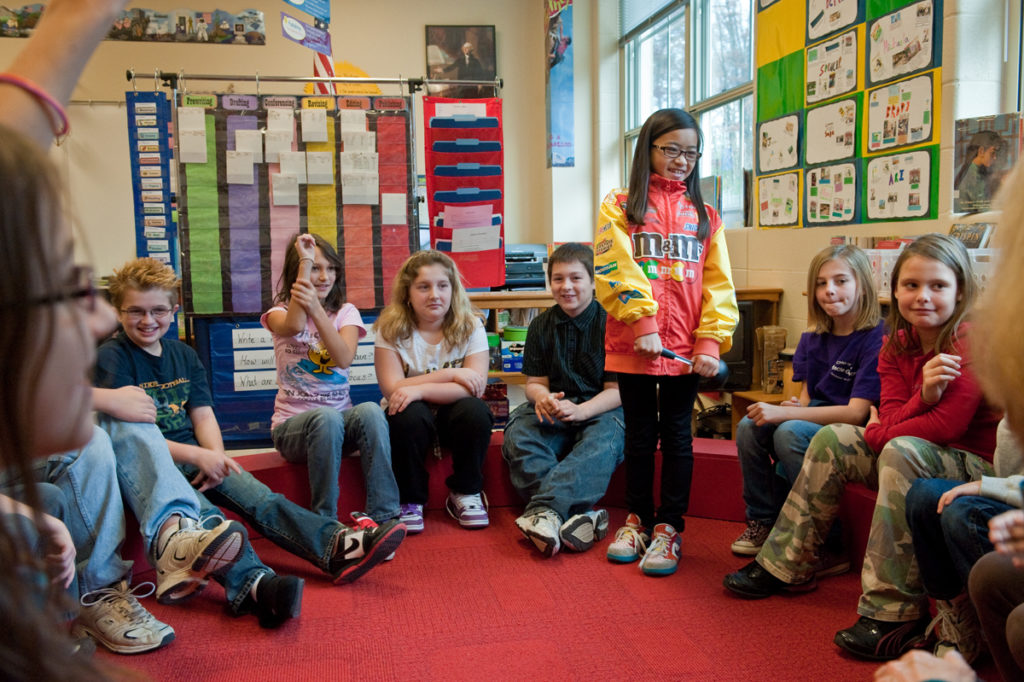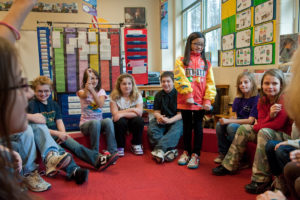

The questions and comments that follow indicate a high level of interest from the other students. Later, the book will be placed in the “Book Nook” and made available for all to see. When Ms. Roberts asks the students how they will take care of the album while it is on loan, they offer suggestions such as “Turn the pages carefully,” “Not more than two kids at a time can look at it,” and “Put it back on the shelf when you are done.”
Ms. Roberts knows how important it is to maintain a strong connection between her classroom and the families who entrust the children to her care. Many schools have well-established routines for meeting and involving families in the life of the school in the beginning of the school year, but contact later in the year is often limited to report card conferences or discussions about problem behavior.
It takes ongoing attention—and a little creativity—to keep the home-and-school connection strong throughout the year. In this article I highlight some practical ways that teachers can do this.
In the opening scenario, the teacher uses family albums as both a way for students to learn about each other’s families and a way for families to feel connected to the life of the classroom. Each family creates an album, with the family and child working together to select and describe the photos that will be used. Some teachers send home a template or form with a space for a photo and lines for the caption.
Teachers can further structure the project by suggesting a theme such as “early moments” or “family celebrations or interests.” Rather than assuming every family has a collection of photos on hand, some teachers send home disposable cameras and ask the children to take photos that capture present-day moments: outings, hobbies, pets, siblings, celebrations, favorite places, etc.
After the albums are constructed, assembled, and embellished, they are shared with the class so that all the students can learn more about the family cultures that comprise their group.
Teachers can also help children create a family museum, where children bring in photos and objects that tell important news and interesting facts about their families. As in the album project, children and families work together to choose items or pictures for display and to write descriptive cards.
The children then arrange the items and photos creatively on classroom walls and shelves. This can be particularly effective if the project coincides with a family open-house so families can view the completed display.
Reciprocally, members of the school community can introduce themselves to families through such a display. One way to do this is to put together a friendly directory with pictures and interesting personal information about the members of the staff.
Families can learn that Mrs. Dishman, the school nurse, breeds and shows Cocker Spaniels, and that Mr. Sinclair not only drives the school bus, but likes to drive an RV on vacation camping trips. Students take turns bringing the directory home and reading it with their families.
Many teachers send home regular classroom newsletters. These newsletters are a great opportunity to inform families about the daily life of the classroom, but classroom newsletters don’t need to be a communication that’s solely from teacher to family or focused just on the classroom.
Children can be responsible for all or part of a regular newsletter. Features could include reports on recent classroom activities, a book review, a description of a game or group activity, or a puzzle or math problem that children and families can do together.
Newsletters can also include a column for exciting and timely family news, where families might tell about the birth of a baby or taking a plane trip to visit relatives. Teachers can send home guidelines to keep the news short and simple. For example, in the first newsletter, teachers can include a boxed column with the heading “Coming Soon, Family News.” In the column, they can include a list of sample family news items and directions for how to send in family news: “Send in your news in five or six sentences, so that we can share it with our classroom community.”
Another way to inform and involve families throughout the year is to invite them to be the audience for children’s creations. For example, when a class of primary students wrote and illustrated an alphabet book, each student was encouraged to take the book home for one night. The teacher put blank pages in the back and asked for family comments about the work the children had done: “Please tell us one thing you found interesting about our work.”
The possibilities for class-created books are endless. Students might write poetry, tell about a field trip, recap a guest speaker’s presentation, summarize a unit of study, or compile a book of favorites.
In addition to welcoming families to respond to class books, the children can invite families to a reading of their poetry, a recitation of a favorite book, a brief concert, or the performance of an original play. Or students can display their artwork and invite families for a “gallery walk.” One first grade teacher held an “air show” at the end of a science unit. Students displayed projects they’d done to explore air, and some of the families made “air cookies” for refreshments.
Special projects and investigations can also involve families in the daily life of the classroom. When a group of kindergarten classes in a rural portion of Pennsylvania were studying horses in preparation for a field trip, for example, they invited families to contribute to their studies.
One mom brought in pictures of her horses and the ribbons and trophies they had won. A learning support teacher, who was also a dad, brought a video of his horse and the western tack he used. Some family members went on the field trip as helpers and a video of the project was made to share with all.
In another school, a class’s questions about mail during a study of the post office grew into a project that connected families with relatives and friends throughout the US. Students and families sent postcards to a friend or family member who lived out of town. The children asked the following:
Please write back and tell us about the place where you live.
Using a map of the US, the students located the spots where the cards were sent to. They devised a chart to tally when cards arrived and the distance they traveled. They made predictions, assumptions, and discoveries. There were at-home conversations about what had been sent back. As letters, photos, notes, and brochures began to arrive, the teacher shared the news with the class and helped the children make a display for families to see.
Finally, the route to good communication with families throughout the year can be a very simple one. Instead of calling or contacting parents only when problems arise, teachers can establish a routine of regular “good news” phone calls.
Imagine how affirming it is for a family to get a phone call saying, “Hi, Mrs. Ayers, I just wanted to let you know about Sean’s success in math today. He quickly grasped the concept of factors and was able to help some other children understand them better.”
If making regular “good news” phone calls doesn’t seem practical, teachers can send home a postcard that tells about a child’s success. Whatever form the communication takes, it’s important to be descriptive rather than evaluative and to be as specific as possible. Instead of “Mary was a big help in art today,” teachers might describe what Mary did that was so helpful: “Mary took the lead in getting the paints put away after art class today.”
The more teachers reach out to students’ families in positive ways throughout the year, the more connected and invested families will be in the life of the classroom and school. This in turn can lead to a more successful year for all.
Kathrine Muller is a certified Responsive Classroom consulting teacher working for NEFC. She has extensive early childhood education experience, including work with Head Start programs. Based in Pennsylvania, she worked more recently as an educational consultant with the Pennsylvania Department of Education. Kathrine has taught early childhood courses at the college level and was the author of a column about childhood called Small Talk.